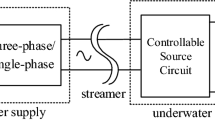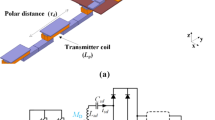Abstract
In harsh marine environments, small variations in parameters of the underwater wireless charging system would lead to system detuning and dynamic fluctuation of DC output, thereby reducing power transfer efficiency and output performance. To achieve maximum efficiency tracking and DC output stabilizing, a decoupling control scheme bridging frequency tracking and DC output stabilizing for the wireless charging system of autonomous underwater vehicles (AUVs) is proposed. To be specific, the primary side of the wireless charging system adopts adaptive frequency tracking control (AFTC) to ensure that the operating frequency can always work near the resonant frequency during the charging process of the lithium battery. The secondary side adopts double closed-loop control of voltage and current based on buck converter such that the DC output can be stabilized for efficiently charging of lithium battery. Experimental results show that the proposed decoupling control scheme can realize frequency tracking on the primary side while the lithium battery can be charged with constant current and constant voltage, under maximum efficiency.
Similar content being viewed by others
References
C. R. Teeneti, T. T. Truscott, N. D. Beal, and Z. Pantic, “Review of wireless charging systems for autonomous underwater vehicles,” IEEE Journal of Oceanic Engineering, vol. 46, no. 1, pp. 68–87, 2021.
J. W. Choi, J. H. Park, J. D. Jung, Y. G. Lee, and H. T. Choi, “Development of an autonomous surface vehicle and performance evaluation of autonomous navigation technologies,” International Journal of Control, Automation, and Systems, vol. 18, no. 3, pp. 535–545, March 2020.
K. H. Zhang, X. Y. Zhang, Z. B. Zhu, Z. C. Yan, B. W. Song, and C. C. Mi, “A new coil structure to reduce eddy current loss of WPT systems for underwater vehicles,” IEEE Transactions on Vehicular Technology, vol. 68, no. 1, pp. 245–253, January 2019.
Z. J. Zheng, N. Wang, and Z. Sun, “Fuzzy PI Compound control of PWM rectifiers with applications to marine vehicle electric propulsion system,” International Journal of Fuzzy Systems, vol. 20, no. 2, pp. 587–596, February 2018.
Y. K. Kwon and J. Y. Lee, “Energy optimization model with variable keep-alive cycle algorithm in wireless sensor network,” International Journal of Control, Automation, and Systems, vol. 17, no. 10, pp. 2531–2540, October 2019.
Y. Dou, D. H. Zhao, Z. W. Ouyang, and M. A. E. Andersen, “Investigation and sesign of wireless power transfer system for autonomous underwater vehicle,” Proc. of 2019 IEEE Applied Power Electronics Conference and Exposition (APEC), pp. 3144–3150, 2019.
Z. C. Yan, B. W. Song, Y. M. Zhang, K. H. Zhang, Z. Y. Mao, and Y. L. Hu, “A rotation-free wireless power transfer system with stable output power and efficiency for autonomous underwater vehicles,” IEEE Transactions on Power Electronics, vol. 34, no. 50, pp. 4005–4008, May 2019.
J. W. Kim, K. B. Kim, H. R. Kim, D. W. Kim, J. Y. Park, and S. Y. Ahn, “An efficient modeling for underwater wireless power transfer using Z-parameters,” IEEE Transactions on Electromagnetic Compatibility, vol. 61, no. 6, pp. 2006–2014, December 2019.
Z. C. Yan, Y. M. Zhang, K. H. Zhang, B. W. Song, and C. Mi, “Underwater wireless power transfer system with a curly coil structure for AUVs,” IET Power Electronics, vol. 12, no. 10, pp. 2559–2565, August 2019.
Y. Naka, K. Yamamoto, T. Nakata, and M. Tamura, “Improvement in efficiency of underwater wireless power transfer with electric coupling,” IEICE Transactions on Electronics, vol. 100, no. 10, pp. 850–857, October 2017.
W. Q. Niu, W. Gu, and J. X. Chu, “Analysis and experimental results of frequency splitting of underwater wireless power transfer,” The Journal of Engineering, vol. 7, no. 7, pp. 385–390, 2017.
M. Tamura, Y. Naka, K. Murai, and T. Nakata, “Design of a capacitive wireless power transfer system for operation in fresh water,” IEEE Transactions on Microwave Theory and Techniques, vol. 66, no. 12, pp. 5873–5884, December 2018.
Z. C. Yan, Y. M. Zhang, K. H. Zhang, and B. W. Song, “Fault-tolerant wireless power transfer system with a dualcoupled LCC-S topology,” IEEE Transactions on Vehicular Technology, vol. 68, no. 12, pp. 11838–11846, December 2019.
X. D. Gao and M. C. Deng, “Tracking performance improvement for operator-based nonlinear robust control of wireless power transfer systems with uncertainties,” International Journal of Control, Automation, and Systems, vol. 17, no. 3, pp. 545–554, March 2019.
Z. J. Zheng, N. Wang, and S. Ahmed, “Maximum efficiency tracking control of underwater wireless power transfer system using artificial neural networks,” Journal of System and Control Engineering, vol. 235, no. 10, pp. 1819–1829, 2021.
Y. Li, W. H. Dong, Q. X. Yang, and S. Jiang, “Automatic impedance matching method with adaptive network based fuzzy inference system for WPT,” IEEE Transactions on Industrial Informatics, vol. 16, no. 2, pp. 1076–1085, February 2020.
R. Hua and P. A. Hu, “Effect of tuning capacitance of passive power repeaters on power transfer capability of inductive power transfer systems,” Wireless Power Transfer, vol. 5, no. 2, pp. 97–104, September 2018.
P. A. Tan, H. B. He, and X. P. Gao, “A frequency-tracking method based on a SOGI-PLL for wireless power transfer systems to assure operation in the resonant state,” Journal of Power Electronics, vol. 16, no. 3, pp. 1056–1066, May 2016.
Z. J. Zheng, N. Wang, and S. Ahmed, “Adaptive frequency tracking control with fuzzy PI compound controller for magnetically coupled resonant wireless power transfer,” International Journal of Fuzzy Systems, vol. 23, pp. 1890–1903, 2021.
M. F. Fu, H. Yin, and C. B. Ma, “Megahertz multiple-receiver wireless power transfer systems with power flow management and maximum efficiency point tracking,” IEEE Transactions on Microwave Theory and Techniques, vol. 65, no. 11, pp. 4285–4293, November 2017.
K. Lu, S. K. Nguang, and S. K. Ji, “Design of auto frequency tuning capacitive power transfer system based on Class-E2 DC/DC converter,” IET Power Electronics, vol. 10, no. 12, pp. 1588–1595, October 2017.
Y. Tian, Y. Sun, Y. G. Su, Z. H. Wang, and C. S. Tang, “Neural network-based constant current control of dynamic wireless power supply system for electric vehicles,” Information Technology Journal, vol. 11, no. 7, pp. 876–883, July 2012.
J. Hou, Q. H. Chen, Z. L. Zhang, S. C. Wong, and C. K. Tse, “Analysis of output current characteristics for higher order primary compensation in inductive power transfer systems,” IEEE Transactions on Power Electronics, vol. 33, no. 8, pp. 6807–6821, August 2018.
Y. S. Yao, Y. J. Wang, X. S. Liu, and D. G. Xu, “Analysis, design and optimization of LC/S compensation topology with excellent load-independent voltage output for inductive power transfer,” IEEE Transactions on Transportation Electrification, vol. 4, no. 3, pp. 767–777, September 2018.
C. Chen, H. Zhou, Q. J. Deng, W. S. Hu, Y. J. Yu, X. Q. Lu, and J. G. Lai, “Modeling and decoupled control of inductive power transfer to implement constant current/voltage charging and ZVS operating for electric vehicles,” IEEE Access, vol. 6, pp. 59917–59928, 2018.
T. Orekan, P. Zhang, and C. Shih, “Analysis, design, and maximum power-efficiency tracking for undersea wireless power transfer,” IEEE Journal of Emerging and Selected Topics in Power Electronics, vol. 6, no. 2, pp. 843–854, June 2018.
W. X. Zhong and S. Y. R. Hui, “Maximum energy efficiency tracking for wireless power transfer systems,” IEEE Transactions on Power Electronics, vol. 30, no. 7, pp. 4025–4034, July 2018.
J. Park, Y. Tak, Y. Kim, Y. W. Kim, and S. W. Nam, “Investigation of adaptive matching methods for near-field wireless power transfer,” IEEE Transactions on Antennas and Propagation, vol. 59, no. 5, pp. 1769–1773, May 2011.
Y. Sun, J. Zhang, Z. H. Ye, and Z. H. Wang, “Characteristic of tuned capacitor in IPT system based on impedance matching,” Journal of South China University of Technology (Natural Science Edition), vol. 44, no. 5, pp. 42–47, May 2016.
R. K. Mai, Y. Chen, Y. Zhang, Y. Li, and Z. He, “Study on secondary compensation capacitor alteration based IPT charging system,” Proceedings of the CSEE, vol. 37, no. 11, pp. 3263–3269, November 2017.
Funding
This work was supported by the China Scholarship Council (CSC) [grant number 201906575007]; Fundamental Research Funds for the Central Universities [grant number 3132019103, 3132019344]; National Natural Science Foundation of China [grant number 51009017, 51379002, 51777024] and the Liaoning Revitalization Talents Program [grant number XLYC1807013].
Author information
Authors and Affiliations
Corresponding author
Additional information
Zhongjiu Zheng received his B.Eng. degree in electronics and information engineering and a Ph.D. degree in electrical engineering from Dalian University of Technology, Dalian, China, in 2003 and 2012, respectively. He is currently an Assistant Professor with the School of Marine Electrical Engineering, Dalian Maritime University, Dalian, China, and also a Visiting Scholar with Electrical and Computer Engineering Department, The University of Texas at San Antonio, San Antonio, TX, USA. His current research interests include underwater wireless power transfer, marine electrical systems and control, and marine electric drive.
Ning Wang received his B.Eng. degree in marine engineering and a Ph.D. degree in control theory and engineering from the Dalian Maritime University, Dalian, China, in 2004 and 2009, respectively. From September 2008 to September 2009, he was financially supported by China Scholarship Council to work as a joint-training Ph.D. student at the Nanyang Technological University (NTU), Singapore. In view of his significant research at NTU, he received the Excellent Government-funded Scholars and Students Award in 2009. From August 2014 to August 2015, he worked as a Visiting Scholar at the University of Texas at San Antonio. His research interests include self-learning modeling and control, unmanned (marine) vehicles, machine learning and autonomous systems. He received the Nomination Award of Liaoning Province Excellent Doctoral Dissertation, and also won the State Oceanic Administration Outstanding Young Scientists in Marine Science and Technology, the China Ocean Engineering Science and Technology Award (First Prize), the Liaoning Province Award for Technological Invention (First Prize), the Liaoning Province Award for Natural Science (Second Prize), the Liaoning Youth Science and Technology Award (Top10 Talents), the Liaoning BaiQianWan Talents (First Level), the Liaoning Excellent Talents (First Level), the Science and Technology Talents the Ministry of Transport of the China, the Youth Science and Technology Award of China Institute of Navigation, and the Dalian Leading Talents. He has authored 3 books, and more than 100 SCI-indexed journal papers. He currently serves as members of IEEE TC on Industrial Informatics, the American Society of Mechanical Engineers (ASME), the Society of Naval Architects and Marine Engineers (SNAME), the Chinese Association of Automation (CAA), and the China’s Society of Naval Architecture and Marine Engineering (CSNAME). He has been Leading Guest Editors of the Neurocomputing, the International Journal of Fuzzy Systems, the International Journal of Advanced Robotics System, and the Advances in Mechanical Engineering. He currently serves as Associate Editors of the International Journal of Fuzzy Systems, the Electronics (MDPI), the Journal of Electrical Engineering & Technology, and the Cyber-Physical Systems (Taylor-Francis).
Sara Ahmed is an assistant professor in Electrical & Computer Engineering Department in the University of Texas at San Antonio. She received her Bachelor’s, Master’s and Ph.D. degrees all in electrical engineering with a power electronics concentration from Virginia Tech, Center for Power Electronics, in 2006, 2007, and 2011, respectively. She has five years of prior industry experience as a Senior Scientist at ABB’s U.S Corporate Research Center in Raleigh, NC. Her primary research interests are in the area of modeling, simulation and analysis of power electronics systems with a focus on control, stability, fault analysis, model prediction, integration of renewables and hardware-in-the-loop modeling and testing. She holds 7 patents, and more than 25 referred publications.
Publisher’s Note
Springer Nature remains neutral with regard to jurisdictional claims in published maps and institutional affiliations.
Rights and permissions
About this article
Cite this article
Zheng, Z., Wang, N. & Ahmed, S. Decoupling Control Scheme Bridging Frequency Tracking and DC Output Stabilizing for Wireless Charging System of Autonomous Underwater Vehicles. Int. J. Control Autom. Syst. 20, 1099–1110 (2022). https://doi.org/10.1007/s12555-020-0542-2
Received:
Revised:
Accepted:
Published:
Issue Date:
DOI: https://doi.org/10.1007/s12555-020-0542-2




